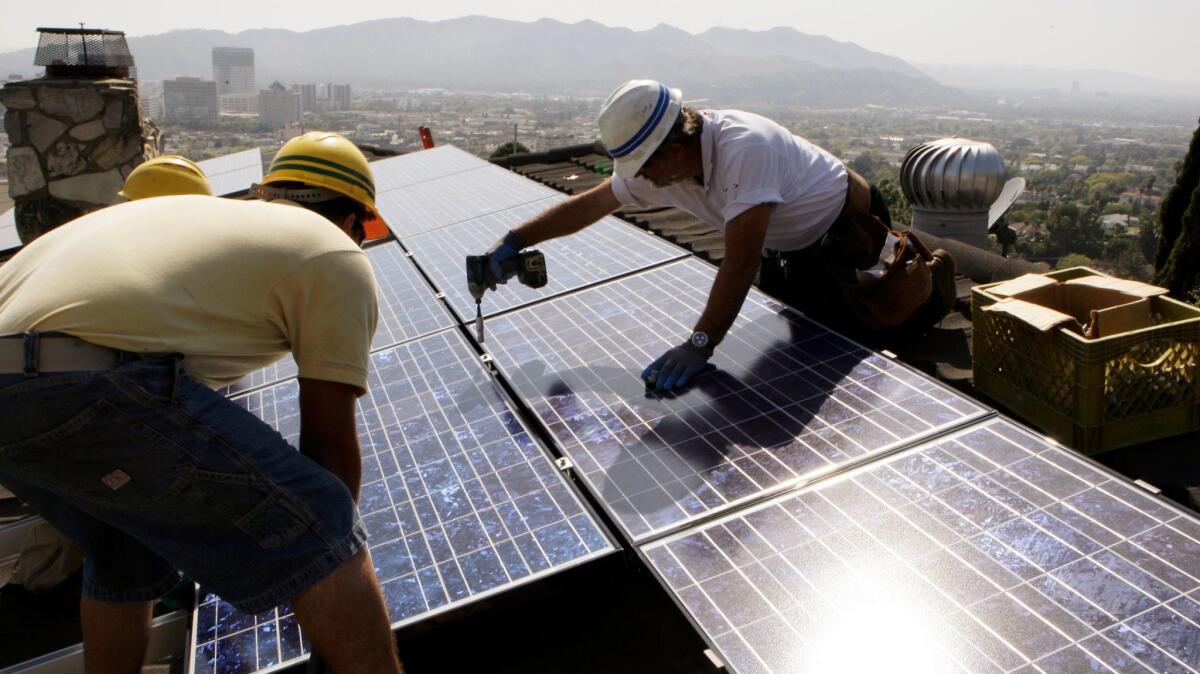Op-Ed: No, Rick Perry, Californiaâs renewable energy policies arenât dangerous for the grid

When Energy Secretary Rick Perry ordered a 60-day review of the âlong-term reliability of the electric gridâ on April 15, he might as well have cited Californiaâs energy policies as the target of his inquiry.
California, after all, is the nationâs leading supporter of renewable energy, which fossil fuel advocates maintain is destabilizing the grid. Regulations and incentives that favor solar and wind power, Perryâs memo said, have âcaused the erosion of critical baseload resources ... destroyed jobs and economic growth, and ⌠threaten to undercut the performance of the grid well into the future.â In other words, Perry has already decided what the study should find: Its purpose is to buttress the Trump administrationâs pro-fossil fuel policies.
Those policies run directly counter to Californiaâs objectives. Legislation passed in 2015 commits the state to procure half its electricity from renewable sources by 2030, a goal it is expected to meet easily. Far more ambitiously, last month the state Senate passed a bill that would shift the 50% requirement to 2025 and set a goal of 100% renewable electricity by 2045.
Fossil fuel advocates argue that Californiaâs energy policies are not just unnecessary (coal and gas are abundant; climate change is iffy), but risky. The iron rule of electrical power is that the amount of electricity fed into the grid must equal the amount it delivers to consumers. If the two numbers diverge enough, the result can be power station and transmission line breakdowns that lead to blackouts.
The argument that renewables will destabilize the grid is nothing more than a reflexive objection from those who see their fossil fuel investments dwindling.
And unlike coal, sunlight and wind are intermittent: The amount of electricity they generate varies from minute to minute, day to day and season to season. That can stress the antiquated grid, which wasnât designed to handle variable electricity flows. To those in the old energy order, that courts disaster.
Itâs true that California has already installed so many solar panels that it occasionally must shut down massive solar farms for hours at a time to keep the grid from being overloaded. And the generation of electricity from the stateâs renewable sources doesnât match demand: Peak solar and wind production occurs at midday, while demand is highest in the late afternoon and early evening when both home and commercial electrical devices are in use.
But the argument that renewables will inherently destabilize the grid is nonsense, nothing more than a reflexive objection from those who see their fossil fuel investments dwindling. Danny Kennedy, managing director of the California Clean Energy Fund, puts it this way: âFossil fuel people used to ignore us. Then they laughed at us and said, âRenewables are too small, too ridiculous.â Now they say, âRenewables are too big, too impactful, too much change for the grid.ââ
As it turns out, it was an unprecedented fossil fuel disaster that showed one way renewables can solve grid-reliability problems, not cause them. The Aliso Canyon natural gas leak in October 2015 was the largest unintended release of greenhouse gases in the nationâs history, but it had one benefit: It pushed the state to take another step in integrating renewable energy into its power supply.
Faced with the loss of 54 billion cubic feet of natural gas storage capacity at Aliso Canyon, and the prospect that gas-fired âpeakerâ plants wouldnât be able to provide needed energy during times of big demand, the California Public Utilities Commission authorized the immediate installation of three lithium ion battery projects. The batteries were designed to provide more than 70 megawatts of electricity, enough to power about 50,000 homes. They can store low-cost midday electricity generated by renewables, then provide it when demand peaks in the afternoon. The battery projects âdemonstrated that actually we didnât have a crisis,â Kennedy said. Theyâve been successfully smoothing out power peaks and valleys in Southern California for more than three months now.
Even the batteries of electric cars could eventually help modernize the grid for renewable energy. When enough of the cars have been sold, utilities will be able to respond to surges in electricity demand or sudden drops in wind or sunshine by briefly interrupting the battery recharging process, increasing available electricity supply.
One of the best ways to incorporate renewable energy into the grid may seem counterintuitive â itâs to make more solar and wind power available over a wider area. If, for example, the partially solar- and wind-powered California grid can extend into other Western states, the greater distribution of electricity supply and demand will smooth out the power supplyâs peaks and valleys. For this reason, the California Independent System Operator, which manages most of the stateâs grid, is trying to expand as far east as Wyoming. That state is resisting because it doesnât want to sabotage its coal industry, but the lower costs of renewables suggest that it will be forced to come around.
Of course, none of this ought to be news to Perry, whose last job was governor of Texas. Texas is Americaâs iconic oil state, but during Perryâs 14-year tenure it became by far the nationâs leading producer of wind energy. And the lights stayed on.
Jacques Leslie is a contributing writer to Opinion.
Follow the Opinion section on Twitter @latimesopinionand Facebook
More to Read
A cure for the common opinion
Get thought-provoking perspectives with our weekly newsletter.
You may occasionally receive promotional content from the Los Angeles Times.










